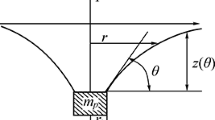Abstract
An estimate is given for the minimum distanceh i at which a particle may approach a bubble during collision under action of forces of a hydrodynamic nature. The thicknessh crit of the film separating the objects being acted upon is calculated when the film fails spontaneously. The collision is considered effective if the conditionh crit≥hi is fulfilled.
Similar content being viewed by others
References
K. L. Sutherland and I. V. York,Principles of Flotation [Russian translation], Metallurgizdat, Moscow (1958).
O. S. Bogdanov and M. Sh. Filanovsky, “Problem of the attachment of mineral particles to air bubbles,”Zh. Fiz. Khim.,14, No. 2 (1940).
R. P. King, T. A. Hatton, and D. G. Hulbert, “Bubble loading during flotation,”Inst. Mining Metallurg. Trans. Sect. C. Mineral Proc. Extract. Metallurg.,83, No. 811, 112–115 (1974).
K. L. Sutherland, “Kinetics of the flotation process,”J. Phys. Colloid. Chem.,52, No. 2, 394–425 (1948).
H. J. Schulze, “Hydrodynamics of bubble-mineral particle collisions,”Inst. Min. Metallurg. Trans. Sect. C. Min. Proc. Extract. Metallurg.,5, No. 1, 43–76 (1989).
S. A. Kondratyev and A. S. Izotov, “Interaction of a “gas-liquid” phase interface with a mineral particle,”Fiz.-Tekh. Probl. Razrab. Polezn. Iskop., No. 4 (1999).
I. Swen-Nielson, “Significance of time of interaction between a mineral and air bubble for flotation,” in:New Research in the Field of Flotation Theory [Russian translation], Otdel Nauchno-tekhnicheskoi Informatsii, Moscow-Leningrad (1937).
J. Drelich, J. D. Miller, J. S. Li, and R. Y. Wan, “Bubble attachment time measurements at a chalcopyrite surface using a high-speed video system,” in:Proceedings of the 20th International Mineral Processing Congress, Aachen, Germany, September 21–26, 1997 3,Flotation and Other Physical-Chemical Processes, 53–64.
V. Ye. Vigdergauz and T. V. Nedosekina, “The wettability of electrodes made of natural metal sulfides,”J. Solid State Electrochem.,2, No. 1, 50–57 (1998).
M. A. Eigeles and M. L. Volova, “On the effect of the temperature of the medium on induction time during attachment of mineral particles to an air bubble,”Dokl. Akad. Nauk SSSR,129, No. 1 (1959).
M. A. Eigeles and M. L. Volova, “Kinetic investigation of the role of the collector during flotation attachment,” Tsvet. Metall. No. 6 (1960).
B. V. Deryagin, “Theory of the heterocoagulation, interaction, and adhesion of different kinds of particles in electrolytic solutions,”Kolloid. Zh.,16, No. 6 (1954).
R. Voghten and G. Petre, “Potentiel de surfage de solutions aqueuses de n-pentanol et de n-heptanol en fonction de la temperature,”J. de Chim. Phys. et de Phys.-Chim. Biolog.,72, No. 11, 1271–1278 (1975).
I. Sawai, “The surface potentials of aqueous solutions of octyl alcohol and caprylic acid,”Trans. Faraday Soc.,30, No. 168, Part 5, 765–769 (1935).
N. N. Rulev, Ye. S. Leshchov, and V. D. Nazarov, “Role of ionic-electrostatic forces in an elementary flotation event,”Khim. Tekh. Vody,2, No. 5 (1980).
A. Bleier, E. D. Goddard, and L. D. Kulkarni, “Absorption and critical flotation conditions,”J. Colloid. Interface Sci.,59, No. 3, 390–504 (1977).
V. A. Chanturiya and R. Sh. Shafeyev,Chemistry of Surface Phenomena during Flotation [in Russian], Nedra, Moscow (1977).
A. A. Abramov, “Character of butyl xanthate and dixanthogenide fixation and the floatability of chalcopyrite,”Obog. Rud, No.4 (1966).
V. A. Chanturiya and V. Ye. Vigdergauz,Electrochemistry of Sulfides. Theory and Practice of Flotation [in Russian], Nauka, Moscow (1993).
A. A. Abramov, “Laws governing the flotation of sericite and chlorite in the presence of cationic collectors,”Obog. Rud, No. 5 (1963).
B. V. Deryagin, “Theory of distortions of the plane surface of a liquid by small objects and its application to measurement of edge wetting angles of thin films of filaments and fibers,”Dokl. Akad. Nauk SSSR,51, No. 7 (1946).
N. N. Rulev and S. S. Dukhin, “Dynamics of the thinning of a liquid film during the inertial impact of a spherical particle against the surface of a bubble in an elementary flotation event,”Kolloid. Zh.,48, No. 2 (1986).
F. Dedek, “Das Anhaften der Luftblasen an der Oberflache der Feststoffe bei der Flotation,”Glückauf-Forschungshefte,30, No. 4, 18–22 (1969).
Additional information
Institute of Mining, Siberian Branch, Russian Academy of Sciences, Novosibirsk, Russia. Translated from Fiziko-Tekhnicheskie Problemy Razrabotki Poleznykh Iskopaemykh, No. 2, pp. 94–103, March–April, 2000.
Rights and permissions
About this article
Cite this article
Kondratyev, S.A., Bochkaryov, G.R. & Izotov, A.S. Conditions for the formation of a “particle-bubble” flotation complex. J Min Sci 36, 175–184 (2000). https://doi.org/10.1007/BF02551798
Received:
Issue Date:
DOI: https://doi.org/10.1007/BF02551798




